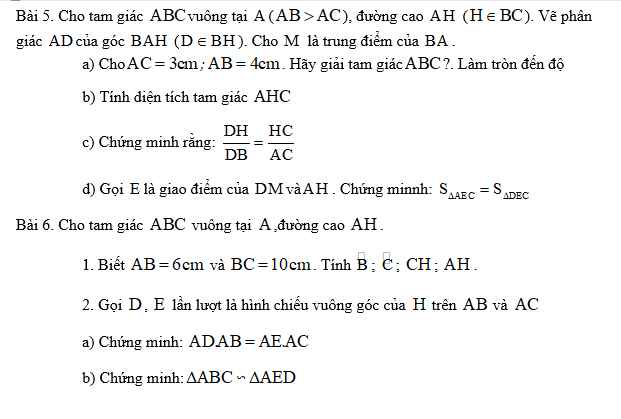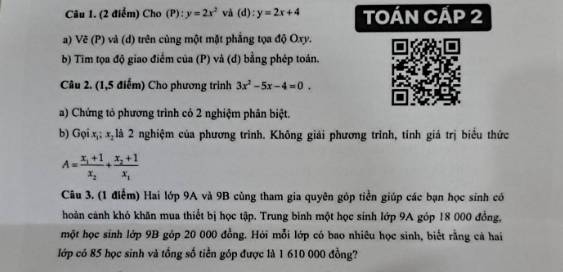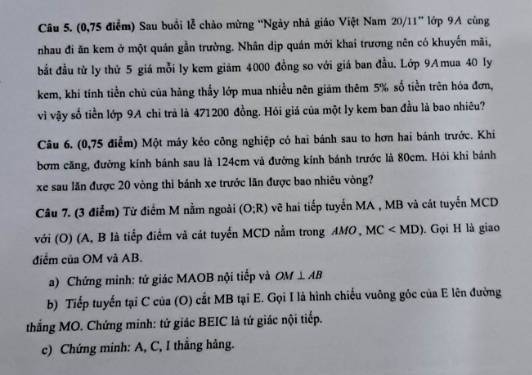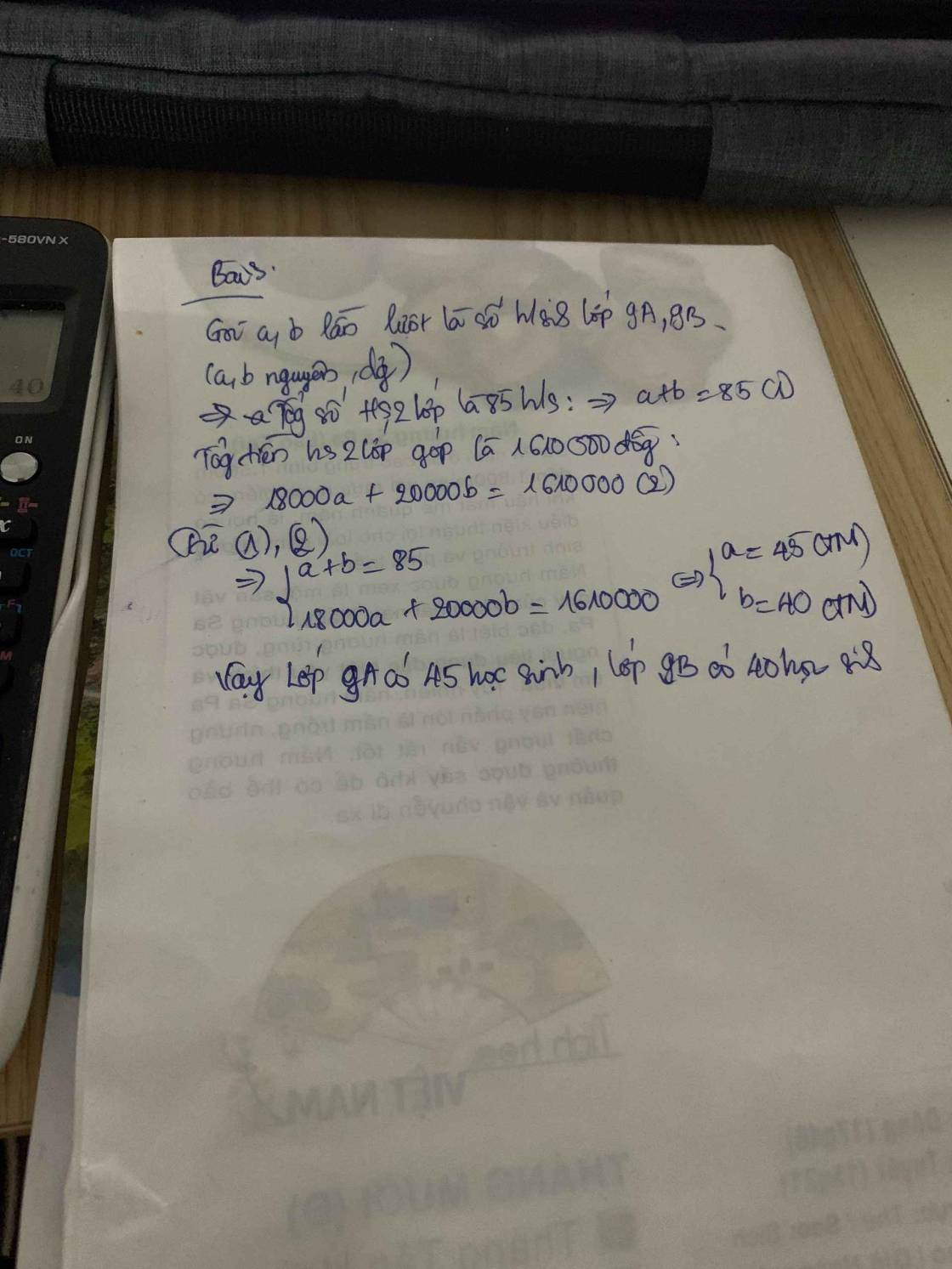
Hãy nhập câu hỏi của bạn vào đây, nếu là tài khoản VIP, bạn sẽ được ưu tiên trả lời.

Giaỉ phương trình sau ;
\(\sqrt[]{4\left(1-x\right)^2}-6=0\)
5phút nữa em pk nộp r mn giúp e nha =((((

Ta có: \(\sqrt{4\cdot\left(1-x\right)^2}=6\)
\(\Leftrightarrow2\left|x-1\right|=6\)
\(\Leftrightarrow\left|x-1\right|=3\)
\(\Leftrightarrow\left[{}\begin{matrix}x-1=3\\x-1=-3\end{matrix}\right.\Leftrightarrow\left[{}\begin{matrix}x=4\\x=-2\end{matrix}\right.\)
\(\Leftrightarrow\left|2\left(1-x\right)\right|=6\)
\(\Leftrightarrow\left[{}\begin{matrix}2\left(1-x\right)=6\\2\left(1-x\right)=-6\end{matrix}\right.\Leftrightarrow\left[{}\begin{matrix}1-x=3\\1-x=-3\end{matrix}\right.\Leftrightarrow\left[{}\begin{matrix}x=-2\\x=4\end{matrix}\right.\)

** Lần sau bạn chú ý viết đề bằng công thức toán
Để \(\sqrt{\frac{1}{x-1}}\) xác định thì \(\left\{\begin{matrix} x-1\neq 0\\ \frac{1}{x-1}\geq 0\end{matrix}\right.\Leftrightarrow x-1>0\Leftrightarrow x>1\)
\(\sqrt{\dfrac{1}{x-1}}\)
\(ĐKXĐ:\dfrac{1}{x-1}>0\Leftrightarrow x-1>0\left(1>0\right)\Leftrightarrow x>1\)

\(a,=\dfrac{\sqrt{2}\left(1+\sqrt{2}\right)}{1+\sqrt{2}}=\sqrt{2}\\ b,=\dfrac{\sqrt{5}\left(\sqrt{3}-1\right)}{\sqrt{3}-1}=\sqrt{5}\\ c,=\dfrac{\sqrt{3}\left(1-\sqrt{2}\right)}{2\left(\sqrt{2}-1\right)}=-\dfrac{\sqrt{3}}{2}\\ d,=\dfrac{\sqrt{5}\left(1-\sqrt{2}\right)}{\sqrt{3}\left(1-\sqrt{2}\right)}=\dfrac{\sqrt{5}}{\sqrt{3}}=\dfrac{\sqrt{15}}{3}\\ e,=\dfrac{\sqrt{7}\left(\sqrt{7}+1\right)}{\sqrt{7}+1}=\sqrt{7}\\ f,=\dfrac{\sqrt{5}\left(\sqrt{5}+1\right)}{\sqrt{5}+1}=\sqrt{5}\\ g,=\dfrac{\sqrt{2}\left(\sqrt{5}-1\right)}{\sqrt{5}-1}=\sqrt{2}\\ h,=\dfrac{\sqrt{5}\left(\sqrt{3}-1\right)}{\sqrt{3}-1}=\sqrt{5}\)

Lời giải:
Để $\sqrt{x^2+3}$ có nghĩa thì $x^2+3\geq 0$
Điều này luôn đúng với mọi $x\in\mathbb{R}$ do $x^2\geq 0, \forall x\in\mathbb{R}\Rightarrow x^2+3>0, \forall x\in\mathbb{R}$
Vậy đkxđ là $x\in\mathbb{R}$

THeo hệ thức (4) ta có \(\frac{1}{AD^2}=\frac{1}{AB^2}+\frac{1}{BC^2}=\frac{1}{12^2}+\frac{1}{16^2}=\frac{25}{2304}\Rightarrow AD=9,6\)
Theo py ta go ta có
\(AD^2=AB^2-BD^2=12^2-9,6^2=51,84\Rightarrow AD=\sqrt{51,84}=7,2\)
\(CD^2=AC^2-ÂD^2=16^2-9,6^2=163,84\Rightarrow CD=12,8\)
\(AC=7,2+12,8=20\)

Bài 5:
a, Áp dụng PTG: \(BC=\sqrt{AB^2+AC^2}=5\left(cm\right)\)
\(\sin B=\dfrac{AC}{BC}=\dfrac{3}{5}\approx\sin37^0\\ \Rightarrow\widehat{B}\approx37^0\\ \Rightarrow\widehat{C}\approx90^0-37^0=53^0\)
b, Áp dụng HTL: \(S_{AHC}=\dfrac{1}{2}AH\cdot HC=\dfrac{1}{2}\cdot\dfrac{AB\cdot AC}{BC}\cdot\dfrac{AC^2}{BC}=\dfrac{1}{2}\cdot\dfrac{12}{5}\cdot\dfrac{9}{5}=\dfrac{54}{25}\left(cm^2\right)\)
c, Vì AD là p/g nên \(\dfrac{DH}{DB}=\dfrac{AH}{AB}\)
Mà \(AC^2=CH\cdot BC\Leftrightarrow\dfrac{HC}{AC}=\dfrac{AC}{BC}\)
Mà \(AH\cdot BC=AB\cdot AC\Leftrightarrow\dfrac{AH}{AB}=\dfrac{AC}{BC}\)
Vậy \(\dfrac{DH}{DB}=\dfrac{HC}{AC}\)








 Mn giúp mik với,bh mik đang cần gấp lắm 19h30 mik phải có bài r nên mn giúp mik với
Mn giúp mik với,bh mik đang cần gấp lắm 19h30 mik phải có bài r nên mn giúp mik với
A